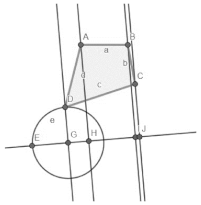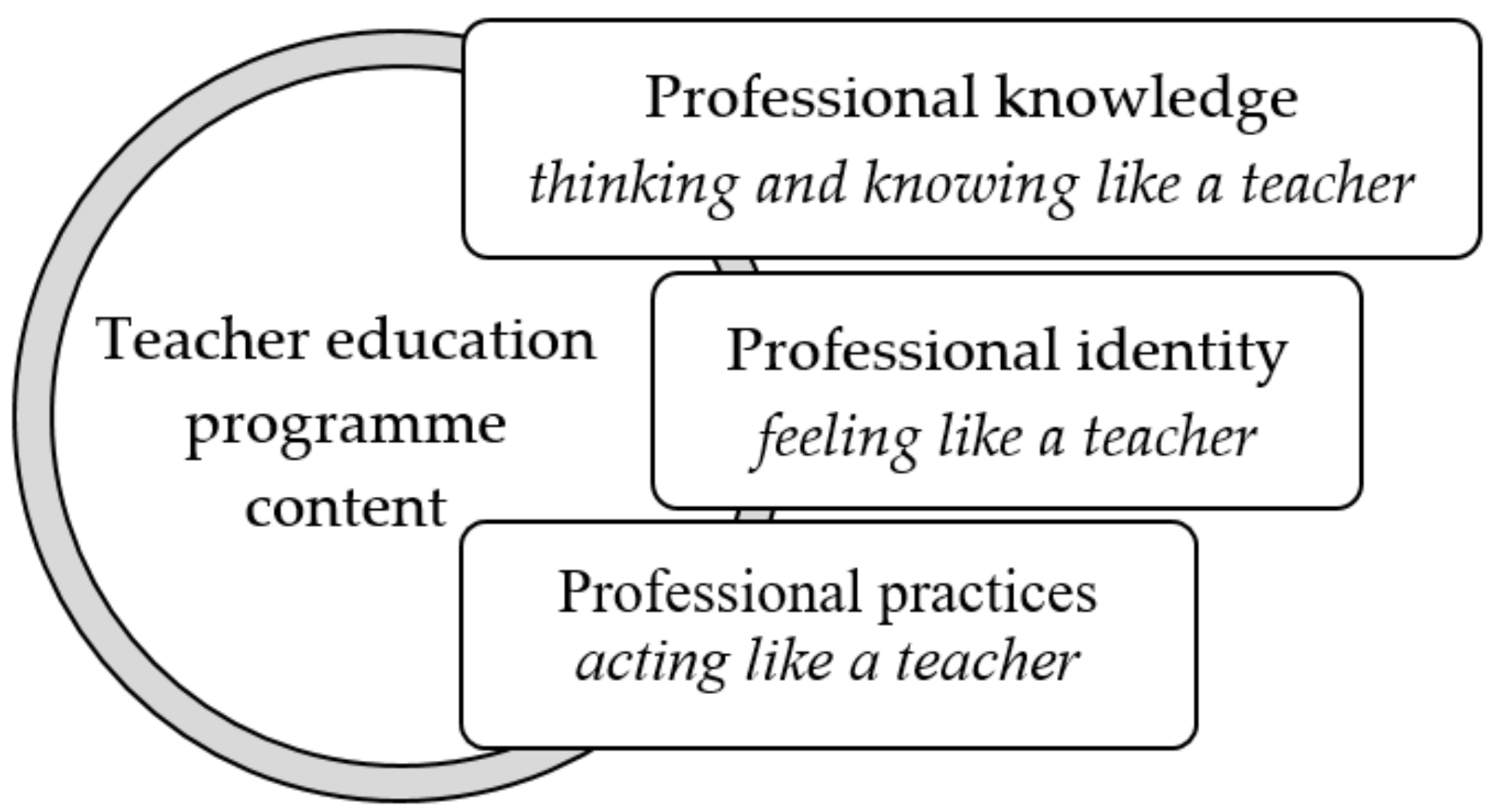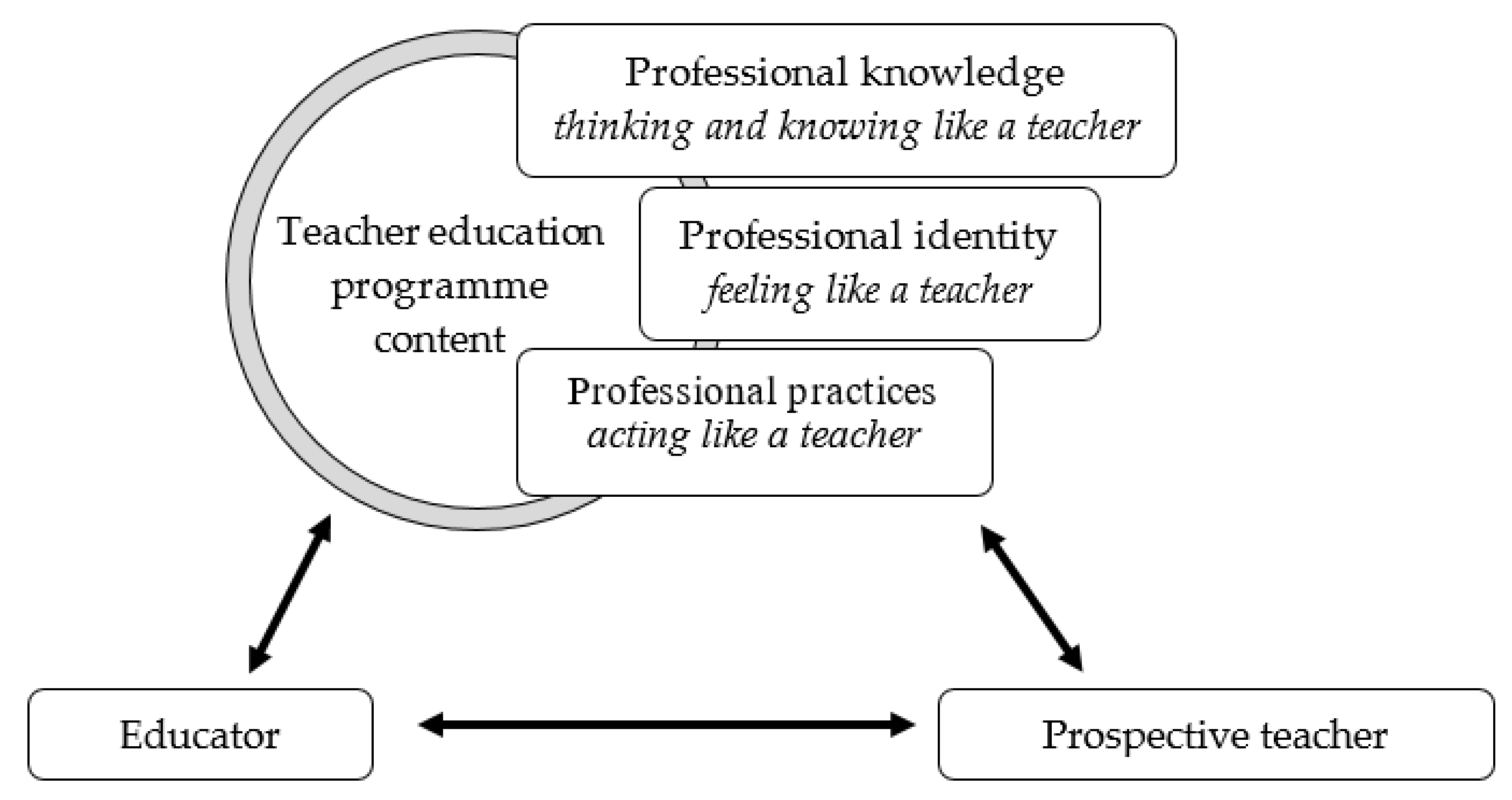The Pedagogical Knowledge Deployed by a Primary Mathematics Teacher Educator in Teaching Symmetry
Abstract
1. Introduction
2. The Pedagogical Knowledge of Primary Teacher Educator
3. Methodological Design
3.1. Context of the Research
3.2. Data Collection and Analysis
4. Analysis
- Lucas:
- OK, so we’re all going to draw a polygon of any kind in Geogebra, without the grid and without axes. Draw it yourselves using the polygon option. [...] It’s curious, we always tend to draw one of the sides parallel to one of the axes. Now the axis of symmetry shouldn’t be parallel to this side, and it shouldn’t be parallel to the base either ... not to this side or the base.
- PPS:
- A straight line?
- Lucas:
- Yes, a straight line. Good, we need another point. No, further down. ... OK [The shared screen shows the following:]

- Lucas:
- The thing about the axis [of symmetry] not being vertical or horizontal, especially it not being vertical—the standard way of representing symmetry—is really hard for them to grasp.
- Lucas:
- Some of the problems which emerge in teacher education are the result poor learning when the trainees were at primary school themselves, and they bring with them to the teacher education course a lot of incorrect notions and concepts they picked up then.
- Lucas:
- By looking closely at the areas of difficulty PPTs have with symmetry, they can anticipate the kind of difficulties which primary pupils can have with symmetry and its properties.
- Lucas:
- Geogebra has the advantage of removing the difficulty that people can have in constructing graphical relationships, so that they can focus on the underlying mathematical relationships.
- Lucas:
- What Geogebra does is enable you to see in real time what happens when—in the case of triangles, for example—when a triangle is displaying certain properties, such as when an angle goes from being acute to being obtuse. Or with a rectangle, it allows you to see your conjectures about properties play out in a way which static geometry cannot match.
- Lucas:
- The problem with this resource, as with others, is that they find it difficult to shed the role of being a learner. I think that if a prospective teacher is going to take on the role of a teacher, they shouldn’t still be learning whatever it is they are going to teach, they need to have moved on from there.
- Lucas:
- Yes, I do try to transmit the idea to them that Geogebra can be a really useful tool in their lessons, but it’s not something I do explicitly [...] I’ve always believed that some kind of isomorphic process happens when you teach [...] What you do in the initial teacher education class bears a certain degree of similarity with what you’d like to see them do in their primary lessons.
- Lucas:
- I’m going to go step by step ... I know that the symmetric point of B is on a line going through B which is perpendicular to the axis. So I tell the programme ‘perpendicular’, and I put a point and a straight line ... on a straight line perpendicular to this axis with this point, but it is on this line. I know that the symmetric point of A is on a straight line which goes through A and is perpendicular to the axis [...] What else do I know? What you said, the distance to the axis is the same as this [indicates a point and its symmetric point]. The other thing I know is that the distance from this point to the perpendicular I’m preparing here is the same as the distance from here to the corresponding point. How can I work that out? How can I put the corresponding point here? What should I do? What function can I use?
- PPT:
- The circle?
- Lucas:
- I don’t know what unit the axis is in ... ‘Circle with Centre through Point’, of course. The centre will be this [indicates a point, G, on the axis] and the point will be this [indicates the point, D], OK?

- Lucas:
- We can look at it two ways: a lack of content knowledge is a barrier to pedagogical content knowledge, and a good grounding in terms of content means you can focus your attention on the teaching–learning processes involved in this content. In my experience, that’s how it is.
- Lucas:
- The course programme, when you look at it from the outside, has a far greater load in terms of MK than PCK [...] Nevertheless, in reality the load is much more balanced, giving MK greater weight, of course.
- Lucas:
- The first thing is that the course content gives a true reflection of what they do in primary education. The second is that the treatment I give this content must equip them to understand it in sufficient depth to be able to mediate it with their pupils. This means they need to go through a stage of unpacking. They need begin to understand the reasons why things are the way they are. [...] This process of unpacking includes coming to understand the issues of teaching and learning a concept, but understanding the concept itself and its connections is essential.
5. Results
6. Discussion
Author Contributions
Funding
Institutional Review Board Statement
Informed Consent Statement
Data Availability Statement
Conflicts of Interest
References
- Masingila, J.; Olanoff, D.; Kimani, P. Mathematical knowledge for teaching teachers: Knowledge used and developed by mathematics teachers educators in learning to teach via problem solving. J. Math. Teach. Educ. 2018, 21, 429–450. [Google Scholar] [CrossRef]
- Chick, H.; Beswick, K. Teaching teachers to teach Boris: A framework for mathematics teacher educator pedagogical content knowledge. J. Math. Teach. Educ. 2018, 21, 475–499. [Google Scholar] [CrossRef]
- Zaslavsky, O.; Leikin, R. Professional development of mathematics teacher educators: Growth through practice. J. Math. Teach. Educ. 2004, 7, 5–32. [Google Scholar] [CrossRef]
- Zopf, D. Mathematical Knowledge for Teaching Teachers: The Mathematical Work of and Knowledge Entailed by Teacher Education. Ph.D. Thesis, The University of Michigan, Ann Arbor, MI, USA, 2010. [Google Scholar]
- Shulman, L.S. Those who understand: Knowledge growth in teaching. Educ. Res. 1986, 15, 4–14. [Google Scholar] [CrossRef]
- Ball, D.L.; Thames, M.H.; Phelps, G. Content knowledge for teaching: What makes it special? J. Teach. Educ. 2008, 59, 389–407. [Google Scholar] [CrossRef]
- Carrillo, J.; Climent, N.; Montes, M.; Contreras, L.C.; Flores-Medrano, E.; Escudero-Ávila, D.; Vasco-Mora, D.; Rojas, N.; Flores, P.; Aguilar-González, A.; et al. The Mathematics Teacher’s Specialised Knowledge (MTSK) model. Res. Math. Educ. 2018, 20, 236–253. [Google Scholar] [CrossRef]
- Rowland, T.; Turner, F.; Thwaites, A.; Huckstep, P. Developing Primary Mathematics Teaching: Reflecting on Practice with the Knowledge Quartet; Sage: London, UK, 2009; pp. 67–100. [Google Scholar]
- Godino, J. Categorías de Análisis de los conocimientos del Profesor de Matemáticas. Rev. Iberoam. Educ. Matemática 2009, 20, 13–31. [Google Scholar]
- Smith, K. So, what about the professional development of teacher educators? Eur. J. Teach. Educ. 2003, 26, 201–215. [Google Scholar] [CrossRef]
- Montes, M.; Carrillo, J.; Contreras, L.C.; Liñán-García, M.M.; Barrera-Castarnado, V. Estructurando la formación inicial de profesores de matemáticas: Una propuesta desde el modelo MTSK. In Investigación Sobre el Profesor de Matemáticas: Formación, Práctica de Aula, Conocimiento y Competencia Profesional; Badillo, E., Climent, N., Fernández-Verdú, C., González-Astudillo, M.T., Eds.; Ediciones Universidad de Salamanca: Salamanca, Spain, 2019; pp. 157–176. [Google Scholar]
- Jaworski, B.; Huang, R. Teachers and didacticians: Key stakeholders in the processes of developing mathematics teaching. ZDM 2014, 46, 173–188. [Google Scholar] [CrossRef]
- Beswick, K.; Chapman, O. Mathematics teacher educators’ knowledge for teaching. In Proceedings of the 12th International Congress on Mathematics Education, Seoul, Korea, 8–15 July 2012. [Google Scholar]
- Ponte, J.P. Mathematics teacher education programs: Practice and research. J. Math. Teach. Educ. 2012, 15, 343–346. [Google Scholar] [CrossRef][Green Version]
- Feiman-Nemser, S. Teacher learning: How do teachers learn to teach? In Handbook of Research on Teacher Education: Enduring Questions in Changing Contexts; Cochran-Smith, M., Feiman-Nemser, S., McIntyre, D.J., Demers, K.E., Eds.; Routledge: New York, NY, USA, 2008; pp. 697–705. [Google Scholar]
- Pascual, M.I.; Montes, M.; Contreras, L.C. Un acercamiento al conocimiento del formador de profesores de matemáticas. In Investigación en Educación Matemática XIX, Proceedings of the XXIII Simposio de la Sociedad Española de Investigación en Educación Matemática, Valladolid, Spain, 7–10 September 2019; Marbán, J.M., Arce, M., Maroto, A., Muñoz-Escolano, J.M., Alsina, A., Eds.; SEIEM: Valladolid, Spain, 2019; pp. 473–482. [Google Scholar]
- Grbich, C. New Approaches in Social Research; SAGE: London, UK, 2003. [Google Scholar]
- Jaworski, B. Mathematics teaching: What is it? Learn. Math. 1992, 12, 8–14. [Google Scholar]
- Escudero-Avila, D.; Montes, M.; Contreras, L.C. What do mathematics teacher educators need to know? Reflections emerging from the content of mathematics teacher education. In The Learning and Development of Mathematics Teacher Educators—International Perspectives and Challenges; Goos, M., Beswick, K., Eds.; Springer: New York, NY, USA, 2020. [Google Scholar]
- Olanoff, D. Mathematical Knowledge for Teaching Teachers: The Case of Multiplication and Division of Fractions. Ph.D. Thesis, The University of Syracuse, Syracuse, NY, USA, 2011. [Google Scholar]
- Ma, L. Knowing and Teaching Elementary Mathematics: Teachers’ Understanding of Fundamental Mathematics in China and the United States; Lawrence Erlbaum: Mahwah, NJ, USA, 1999. [Google Scholar]
- Contreras, L.C.; Montes, M.; Muñoz-Catalán, M.C.; Joglar, N. Fundamentos teóricos para conformar un modelo de conocimiento especializado del formador de profesores de matemáticas. In Avances, Utilidades y Retos del Modelo MTSK, Proceedings of the III Jornadas del Seminario de Investigación de Didáctica de la Matemática de la Universidad de Huelva, Huelva, Spain, 17–18 July 2017; Carrillo, J., Contreras, L.C., Eds.; CGSE: Huelva, Spain, 2017; pp. 11–25. [Google Scholar]
- Montes, M.; Contreras, L.C. Las creencias de los formadores de profesores que enseñarán matemáticas sobre el contenido y la estructura de la formación inicial de los profesores de secundaria. In Proceedings of the IV Congreso Iberoamericano sobre Conocimiento Especializado del Profesor de Matemáticas, Huelva, Spain, 7–10 September 2019; Carrillo, J., Codes, M., Contreras, L.C., Eds.; Universidad de Huelva Publicaciones: Huelva, Spain, 2019; pp. 14–23. [Google Scholar]
- Bassey, M. Case Study Research in Educational Settings; Open University Press: London, UK, 1999. [Google Scholar]
- Stake, R. The Art of Case Study Research; Sage: Thousand Oaks, CA, USA, 1995. [Google Scholar]
- Stake, R.E. Qualitative Case Studies. In The Sage Handbook of Qualitative Research, 3rd ed.; Denzin, N.K., Lincoln, Y.S., Eds.; Sage Publications: Thousand Oaks, CA, USA, 2005; pp. 166–443. [Google Scholar]
- Flick, U. Introducción a la Investigación Cualitativa; Morata: Madrid, Spain, 2007. [Google Scholar]
- Baxter, J.A.; Lederman, N.G. Assessment and measurement of pedagogical content knowledge. In Examining Pedagogical Content Knowledge. The Construct and its Implications for Science Education; Gess-Newsome, J., Lederman, N.G., Eds.; Kluwer: Dordrecht, The Netherlands, 2001; pp. 147–161. [Google Scholar]
- Perks, P.; Prestage, S. Planning for Teaching. In Mentoring in Mathematics Teaching; Jaworski, B., Watson, A., Eds.; Falmer: London, UK, 1994; pp. 65–82. [Google Scholar]



| Knowledge about How to Teach Programme Content | Knowledge about the Characteristics of PPTs’ Learning | Knowledge about the Standards and Norms of Primary Teacher Education Programmes |
|---|---|---|
| Analysis of the potential of different representations of symmetry | Foreseeing PPTs’ difficulties with respect to the mathematical content of axial symmetry | The contents of teacher education should start from a grounded study of primary content |
| Choice of nonstandard examples regarding the relative position of shapes involved in the symmetry | Consideration of the PPTs’ duality as students of mathematics and as future teachers | PPT education should include elements that enable the unpacking of mathematical content |
| Reflection on PPTs’ errors vis-à-vis symmetry aids their understanding of pedagogical aspects of their teaching | PPTs’ misunderstandings of symmetry hinder the construction of knowledge about how it might be taught | |
| Use of Geogebra and reflection about its potential as a training resource with PPTs | ||
| The possibility of methodological transference from teacher training to primary education (methodological isomorphism) |
Publisher’s Note: MDPI stays neutral with regard to jurisdictional claims in published maps and institutional affiliations. |
© 2021 by the authors. Licensee MDPI, Basel, Switzerland. This article is an open access article distributed under the terms and conditions of the Creative Commons Attribution (CC BY) license (https://creativecommons.org/licenses/by/4.0/).
Share and Cite
Pascual, M.I.; Montes, M.; Contreras, L.C. The Pedagogical Knowledge Deployed by a Primary Mathematics Teacher Educator in Teaching Symmetry. Mathematics 2021, 9, 1241. https://doi.org/10.3390/math9111241
Pascual MI, Montes M, Contreras LC. The Pedagogical Knowledge Deployed by a Primary Mathematics Teacher Educator in Teaching Symmetry. Mathematics. 2021; 9(11):1241. https://doi.org/10.3390/math9111241
Chicago/Turabian StylePascual, Mª Isabel, Miguel Montes, and Luis Carlos Contreras. 2021. "The Pedagogical Knowledge Deployed by a Primary Mathematics Teacher Educator in Teaching Symmetry" Mathematics 9, no. 11: 1241. https://doi.org/10.3390/math9111241
APA StylePascual, M. I., Montes, M., & Contreras, L. C. (2021). The Pedagogical Knowledge Deployed by a Primary Mathematics Teacher Educator in Teaching Symmetry. Mathematics, 9(11), 1241. https://doi.org/10.3390/math9111241







